Shigaraki 信楽
|
Title   • File Name • File Name   • Date • Date   • Position • Position   |
|
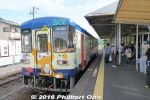
Shigaraki Station on the Shigaraki Kogen Railway Line. One-car train, diesel powered.To reach Shigaraki by train, first get on the JR Kusatsu Line, get off at Kibukawa Station where you transfer to the Shigaraki Kogen Railway Line.
|
|
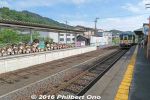
On the Shigaraki Kogen Railway Line, get off here at Shigaraki Station at the end of the line. 信楽駅 MAP
|
|

Shigaraki Station platform decorated with tanuki raccoon dogs.
|
|
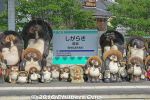
Shigaraki Station platform decorated with tanuki raccoon dogs.
|
|

Shigaraki Kogen Railway train.
|
|

More tanuki greet you at Shigaraki Station.
|
|
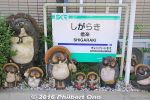
Tanuki greet you at Shigaraki Station.
|
|

Local sights.
|
|
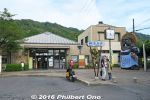
Shigaraki Kogen Railways Shigaraki Station. You can take a bus to reach Shigaraki Ceramic Cultural Park in 5 min., or walk for 20 min. 信楽駅
|
|

By now, you will notice that the tanuki (racoon dog) is the symbol of Shigaraki. This giant tanuki greets you at Shigaraki Station. Wish they removed that pay phone.
|
|

Inside Shigaraki Station.
|
|

Inside Shigaraki Station waiting area. There's a display case in the corner.
|
|
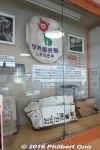
Display case in the corner shows a few pieces from the wrecked train in the 1991 accident.On the morning of May 14, 1991, a Shigaraki Kogen Railway train bound for Kibukawa collided head on with a special JR West train traveling from Kyoto to Shigaraki. It left 42 people, including five SKR employees, dead and 614 injured. Also see photos below of the monument near the accident site.
|
|
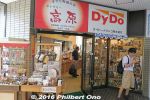
Gift shop inside Shigaraki Station. In case you forgot buy someting for someone before you leave Shigaraki.
|
|
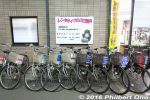
Rental bicycles at Shigaraki Station.
|
|

One of Japan's renown and historical centers for pottery, Shigaraki's heart is the Shigaraki Ceramic Cultural Park.
|
|

On the Shigaraki Kogen Railway Line, get off at Shigaraki Station at the end of the line. 信楽駅
|
|

Shigaraki Station 信楽駅
|
|

Shigaraki Kogen Railways Shigaraki Station. You can take a bus to reach Shigaraki Ceramic Cultural Park in 5 min., or walk for 20 min. 信楽駅
|
|

Giant tanuki at Shigaraki Station. Wish they removed that pay phone.
|
|

Welcome to Shigaraki. On special days such as pottery fairs, just follow the crowd from the train station.
|
|

Along the way, you will see pottery shops with tanuki dolls to catch your attention.
|
|

Similar to the beckoning cat, the Shigaraki tanuki is a common good luck charm placed at the entrance of homes and shops. Tanuki of all sizes for sale year round.
|
|

A great time to visit Shigaraki is during the Shigaraki Pottery Festival (信楽陶器まつり) and Ceramic Art Market in mid-Oct. Bridge to the Shigaraki Pottery Fair in mid-Oct.
|
|

The bridge obviously has ceramic materials.
|
|

Shigaraki Toki (Pottery) Matsuri banner
|
|

This is one of two pottery fair sites during the Shigaraki Pottery Festival.
|
|

Numerous Shigaraki pottery vendors display and sell their wares. MAP
|
|
|
|
|

If you like the tanuki raccoon dog, this is the place to be.
|
|
|
|
|
|

The tanuki have different faces and doing different things, even karaoke. Didn't see any looking like a photographer though.
|
|

Tanuki faces. This one is probably the most typical in the modern age.
|
|
|
|
|
|
|
|
|
|
|

Shigaraki tanuki is said to bear Eight Lucky Omens (八相縁起).Shigaraki tanuki is said to bear Eight Lucky Omens (八相縁起). 1. The hat is protection from unexpected disasters. 2. The smiling face is for affability, 3. The large eyes is for seeing the situation and making correct and considerate decisions, 4. The large belly is for being calm as well as bold, 5. A sake flask in the left hand for innate virtue, 6. An unpaid bill in the left hand symbolizes trust, 7. Large gonads between the legs which is the money bag for prosperity, and 8. A thick tail for reliability and stability no matter what.
|
|

Sports tanuki
|
|
|

Mail box
|
|

Owls too
|
|

Frog is "Kaeru" which means to "return." A popular ornament at house entrances (exits) and gardens.
|
|

This frog will supposedly have your money "returned."
|
|

Pig
|
|

Bowls
|
|

Prices are quite reasonable. They sell pottery for any type of budget.
|
|

Vases
|
|
|

Bargains to be found.
|
|

Pottery vendor
|
|
|

Lemme outta here...
|
|

Koka City Hall, Shigaraki Branch
|
|

A warehouse converted into a pottery fair.
|
|
|
|

A short bus ride takes you to Shigaraki Ceramic Cultural Park, opened in June 1990. Open from 9 am to 5 pm, closed on Mon. (open if a national holiday and closed on Tue.). This is Shigaraki's main attraction and home of Shigaraki-yaki pottery.
|
|

Shigaraki Ceramic Cultural Park is called Togei no Mori in Japanese. It is operated by Shiga Prefecture. Free admission. 陶芸の森 MAP
|
|

Shigaraki Ceramic Cultural Park is in a large park-like area with various pottery facilities such as this Exhibition Hall of Industrial Ceramics. 産業展示館
|
|

When I visited in mid-Oct., the Shigaraki Ceramic Cultural Park was holding the Ceramic Art Market. Notice the tents for the ceramic artists selling their works.
|
|

The Ceramic Art Market in Shigaraki Ceramic Cultural Park has ceramics artists having their own booth to sell their wares.
|
|
|
|
|
|
|

Shigaraki Tanuki mascot walked around the site.
|
|

Confection
|
|

Inside the Exhibition Hall of Industrial Ceramics. 産業展示館
|
|

Steps going up the hill at Shigaraki Ceramic Cultural Park. Good exercise.
|
|

Greenery at the Shigaraki Ceramic Cultural Park.
|
|

Azaleas would be beautiful in early May.
|
|

At the top of the hill is the Museum of Contemporary Ceramic Art called Togeikan. 陶芸館
|
|

Shigaraki Ceramic Cultural Park also has pottery kilns. Here's one "Anagama" cave kiln.
|
|

Pottery kilns require large amounts of wood.
|
|

"Anagama" kiln diagram and explanation in Japanese and English.
|
|

Noborigama sloping kiln 登り窯
|
|

"Anagama" kiln.
|
|

"Noborigama" sloping kiln 登り窯
|
|

Side entrances of noborigama kiln. 登り窯
|
|

Inside the kiln. This one was open and empty, but some were closed and you could feel the warmth on the door.
|
|

Inside a side entrance of a noborigama kiln. 登り窯
|
|

"Noborigama" kiln explanation in Japanese and English. 登り窯
|
|

"Noborigama" kiln
|
|

Ceramic seats
|
|

More outdoor ceramic art. This is outside the Institute of Ceramic Studies where invited artists in residence create and do research and workshops and lectures are held.
|
|

At the parking lot is this Tanuki-kan store full of tanuki.
|
|

Inside Tanuki-kan store.
|
|

Free shuttle bus to move between the ceramic park, pottery fair, and train station.
|
|
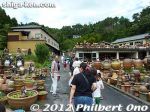
Shigaraki has a good number of pottery centers and Sotoen (宗陶苑) is major one. I visited for the first time in Aug. 2012. It covers a large ceramic park-like area.
|
|
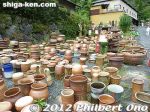
Sotoen has a very large number of Shigaraki pottery pieces outside in park-like tract. All for sale. Shigaraki ware is known for its weather-resistance, so they are suited for gardens and outdoor use.
|
|

Racks and racks of Shigaraki tanuki or racoon dogs.
|
|
|

Photo op at Sotoen. They got almost everything you can imagine. The giant tanuki is priced as much as 700,000 yen.
|
|

Overview of the heart of Sotoen.
|
|
|
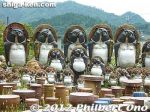
Tanuki for sale at Sotoen, Shigaraki.
|
|
|
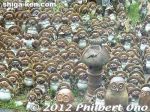
Smaller tanuki cost a few thousand yen.
|
|

They also have owls. This one has a camera.
|
|

Crayon no Shinchan.
|
|
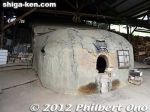
Sotoen's main attraction is this noborigama or sloping kiln. Japan's oldest noborigama. The bottom chamber is the furnace where they burn wood. 登り窯
|
|

Sotoen's noborigama kiln is 15 meters wide, 30 meters long, and 3.5 meters high. It has eleven chambers going up a slope. 登り窯
|
|
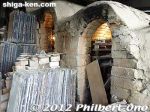
The heat from the furnace at the bottom chamber rises and seeps into all the chambers. 登り窯
|
|

A noborigama chamber. The chambers get larger toward the top of the noborigama kiln. 登り窯
|
|
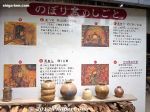
"Noborigama" kiln explanation in Japanese. It takes 40-50 days to fill the kiln, and 7-10 days to fire. 登り窯
|
|
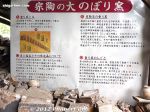
"Noborigama" kiln explanation in Japanese
|
|

The top of the noborigama kiln.
|
|
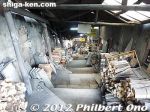
Steps along the side of the noborigama kiln.
|
|
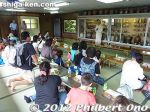
A talk about Shigaraki ware at Sotoen.
|
|
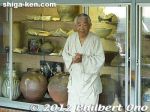
A talk about Shigaraki ware at Sotoen.
|
|
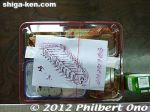
Bento lunch at Sotoen.
|
|
|
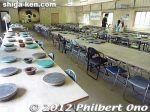
Another highlight of Sotoen was a pottery lesson for beginners. They have a huge pottery classroom.
|
|

First, an instructor demonstrated the basics of pottery making with a block of clay. Easy enough for anyone to make a simple bowl or cup.
|
|

The instructor showed how to smooth the top edge with a wet cloth.
|
|

Here's our block of Shigaraki clay.
|
|

After maybe 20-30 min., my little bowl.
|
|
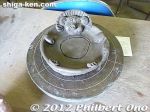
Another person got more creative. We were going to see the result in Sept.
|
|

Sotoen gift shop.
|
|
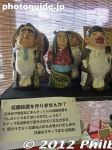
They even can make Shigaraki figurines based your likeness if you give them photos of your face.
|
|

Large tanuki.
|
|
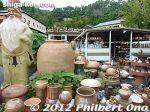
Pottery everywhere at Sotoen.
|
|
|
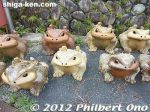
Frogs are another auspicious pottery piece. Sotoen Web site: shigarakiyaki.co.jp
|
|

If you go to Shigaraki by car, you will see large pottery shops along the road catching your eye with giant tanuki and small tanuki armies.
|
|

Giant tanuki dressed as a Yokozuna grand champion sumo wrestler.
|
|

Inside a large pottery shop.
|
|

This pottery shop also offers pottery classes.
|
|

Also in Shigaraki is Miho Museum, designed by I.M. Pei, in the middle of the mountains. From Shigaraki Station, it's a 25-min. bus ride. (Or 50 min. by Teisan Bus from JR Ishiyama Station in Otsu.) This nice tunnel leads to the museum.
|
|
|
|

Entrance to Miho Museum which has an excellent collection of art from most parts of the world. Photography is not allowed inside the museum. MAP
|
|

Miho Museum has several exhibition rooms featuring art from various parts of the world. It also has a restaurant and coffee shop.
|
|

Shigarakigushi Station on the Shigaraki Kogen Railway Line. This is where you get off to see the Shigaraki-no-miya Palace Ruins or the train accident memorial. 紫香楽宮跡駅
|
|

Vending machine trash bin with tanuki design at Shigarakigushi Station.
|
|

Shigaraki-no-miya Palace ruins. National Historic Site MAP
|
|

Kyoto-based Emperor Shomu first built a Detached Palace in Shigaraki in 742. This became the the Shigaraki-no-miya Palace.
|
|
|

Ruins of a gate. Only the stone foundations are left. No original buildings stand.
|
|

Another theory says that this is the ruins of Kokaji temple. 甲賀寺
|
|
|
|

A small shrine stands as a memorial.
|
|
|
|

There are stone markers indicating where various buildings were.
|
|
|
|

Stone foundation for a pillar.
|
|
|

The Shigaraki Kogen Railway between Kibukawa and Shigaraki Stations is a single railway.
|
|

On the morning of May 14, 1991, a Shigaraki Kogen Railway train bound for Kibukawa collided head on with a special JR West train traveling from Kyoto to Shigaraki.The accident occurred May 14, 1991, when an SKR train collided head-on with a JR West train in Shigaraki, Shiga Prefecture, leaving 42 people, including five SKR employees, dead and 614 injured.
|
|

Forty-two people died, and over 600 were injured. The JR West train was packed with people heading to Shigaraki for the World Ceramic Festival. The front cars of the two trains formed an upside-down V.
|
|

The accident was due to a train signal mixup and human error.
|
|

Another place to visit in Shigaraki.
|
|

Resembling a pair of praying hands, the train accident memorial is right next to the railway track.
|
|

Stone plaque with the names of the 42 fatalities, including five employees of Shiga Kogen (Highland) Railways (SKR).
|
|
|

JR trains no longer run to Shigaraki directly.
|
|

Memorial for Safety
|
|

The memorial is a short walk from Shigarakigushi Station.
|
|

Art work on a vending machine.
|
|
|
|
|